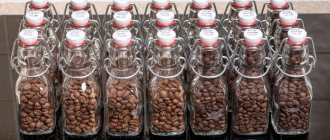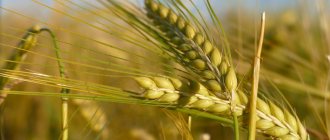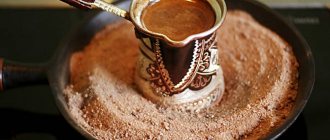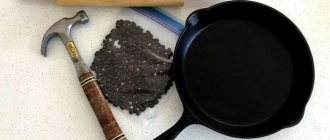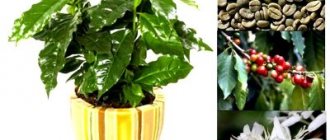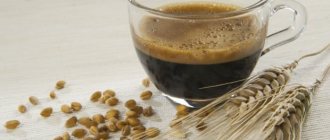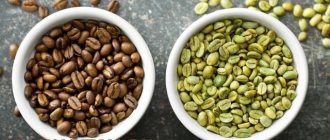Coffee harvest in Colombia it lasts the entire season - up to several months a year. Every country that produces coffee shifts it according to weather conditions in the same weeks and months spread throughout the year. For example, Guatemala collects coffee from August to May, while Indonesia (Java) collects coffee from July to December. Brazilian coffee is harvested from April to August.
The fruits of Robusta and Liberica coffee varieties are notable for the fact that they do not fall off when the degree of ripeness is exceeded, due to which they dry directly on the branches of the tree. Arabica is harvested in several stages during the ripening of the grain, with an interval of approximately a couple of weeks. These fruits are collected in three stages, which ensures high-quality ripening of the fruit. Overripe coffee fruits do not just turn blue or gray, but turn black. Having discovered this phenomenon, coffee plantation workers begin to harvest coffee - the blackened fruits easily fall off, and no amount of careful processing will restore the quality lost due to overripeness. Fruits that fall from a great height of the tree begin to rot and are subsequently discarded. In general, coffee is collected using several methods.
Machine harvesting
Brazil's vast plateaus provide ideal conditions for growing coffee. On the local plantations, impressively sized machines are used to harvest the harvest from carefully planted rows of coffee trees. The principle of their operation is simple: these machines shake the tree until the fruits fall from it. It is impossible to list all the disadvantages of such a harvest, but the most unpleasant thing is that unripe ones fall along with the ripe berries. After all, the fruits on one branch do not ripen synchronously and ripe and unripe berries grow on each branch. The machine does not distinguish between them and collects all the fruits at once. Therefore, after harvesting, the berries are sorted, separating ripe from unripe and getting rid of mixed knots and leaves. The production of such coffee will cost the farmer much less than if he harvested the crop in any other way, but, alas, this comes at the expense of quality.
Conditions for growing coffee
Depending on how the coffee is grown and what protection methods farmers use, a high yield is achieved.
- Stable climate without seasonal temperature fluctuations. As a rule, plantations are preferred to be located in the equatorial belt.
- Loose soil. Coffee thrives on volcanic slopes thanks to the presence of organic remains.
- Temperature regime. 13-27 degrees Celsius above zero is the acceptable range within which fruits ripen according to schedule.
- Daylight. Trees love abundant but diffused sunlight.
- Sufficient amount of moisture. The area with annual precipitation of 3500 mm is considered the most comfortable.
Are there differences between how Arabica and Robusta coffee grow? The second type is not too whimsical, resistant to fungi. Therefore, breeders began to cross both varieties, creating a hybrid that was less susceptible to disease. This approach reduces the taste and aroma characteristics of the grains and, accordingly, is not in demand.
Strip picking
Since machines are useless in mountainous areas, a considerable part of the coffee is still collected by hand. One of the easiest ways is to remove all the berries from the branch with a deft movement of your hand. Like machine stripping, the collection is very fast, but not very accurate. Moreover, the coffee tree is often damaged as a result of using this method. Although stripping does not require expensive equipment, and the collection area can be anywhere, you will still have to separate ripe berries from unripe ones.
Terroir
The first thing I would like to mention is terroir. This concept came into the “coffee dictionary” from the wine environment, and it denotes a set of growing conditions, the environment of origin of the coffee bean. Terroir provides a variety of varieties, giving each of them special characteristics. Since each type of terroir is different, the characteristics of coffee grown in different conditions will also be different. In other words, terroir is what distinguishes African coffee from American coffee, and Ethiopian from Brazilian, Colombian and Indonesian.
Terroir includes many parameters, including temperature, amount of precipitation and sunlight, intensity of solar radiation, etc. A person can exert his direct influence only on the composition of soils. The most important indicator of terroir is the altitude of coffee growing. The larger it is, the slower the metabolism of the coffee tree. High altitude leads to the formation of a rich set of acids in the grain. Therefore, the more meters in a particular region, the wider the acid spectrum of the coffee in the cup. Is it difficult to imagine how the composition of the soil or the weather can affect the taste of a drink prepared in a coffee shop several thousand kilometers away? Then continue reading!
Hand picking
Picking remains the most effective way to harvest first-class coffee.
In this case, only ripe berries are selected, and those that are not yet ripe remain. Of course, there is a temptation that pickers, who are paid by the weight of the berries they pick, will also pick unripe fruits for greater weight. However, farmers, who understand how hard such work is, try to encourage the collection of ripe fruits.
A look inside the grain
Our journey begins with one Arabica coffee bean. If this grain were a prison, it would have over 4,500,000 prison cells. Now imagine that we made a cross-section through the middle of the grain from the previous picture.
The following picture shows a cross section of a roasted coffee bean. Notice those tiny holes in the grain. Each of them was a living cell while the bean ripened inside the berry on the coffee tree.
This image was taken using an electron microscope at 750x magnification, so you can see each cell individually. The width of each of them is approximately half the thickness of your hair (50-70 microns).
As coffee beans roast, the cells fill with carbon dioxide and expand. The walls of each of them contain soluble substances that should end up in our coffee.
Soluble is a general term used to name the water-soluble substances found in coffee beans. Basically, the process of brewing coffee is using water as a solvent to remove substances from the cells of the coffee bean.
Soluble substances come in different shapes and sizes. The picture above describes the four main categories of substances found in coffee beans and the unique aromatic notes that each contributes to the taste of coffee.
Fruit acids and caffeine dissolve the fastest and are responsible for light and fruity notes.
Lipids are natural fats and oils found in coffee beans. They are not technically water soluble, but water still releases them from the coffee cell as an emulsion.
Coffee brewing methods that use metal filters, such as French press and espresso, allow lipids to be released into the cup, creating the distinctive flavor experience associated with these methods.
The pores in paper filters are so small that they prevent the passage of most lipids. Coffee brewed using a drip method, such as pour over, will only contain 1/10 of the lipids found in coffee brewed using a metal filter.
During the Maillard reaction, when coffee is roasted, melanoids are formed, which are responsible for the brown color of both the bean itself and the coffee liquid.
Carbohydrates make up about 50% of the dry weight of coffee beans, but only some of them are soluble. They play a major role in giving the drink its sweetness and earthy flavor.
As the coffee cherry ripens on the tree, Mother Nature locks these innocent substances into the cells of each coffee bean.
Here we are again inside the coffee bean, in that very “prison” for our substances. After the ripened grain has been harvested, processed and roasted, the soluble substances are still locked in their prisons. But at least the inside already smells delicious.
*Please note that the colored balls represent soluble substances and are not drawn to scale.
This is where water comes to our aid! When it enters the coffee cells, it begins to extract soluble substances. The resulting solution is called coffee.
Fallen berries
Without exception, farmers must collect all the fruits that fall from the tree, whether they are ripe or not. They are kept separately and then mixed with low quality coffee, which happens even with the best farms. You cannot leave fallen berries on the ground under trees. They attract various pests, such as the coffee beetle
Producers who care about the quality of their coffee make sure that pickers pick berries of the same ripeness.
Labor shortage
It is becoming increasingly difficult for farmers to pay for manual coffee picking; today, the payment of pickers' labor constitutes the bulk of production costs. This is one of the reasons why coffee produced in a developed country, such as Hawaiian Kona, is very expensive. Where the economy is thriving, people don't want to make a living picking berries. Coffee farms in Central America often employ workers who migrate from one country to another, harvesting the crop at different times of the year. Today, most of these pickers are Nicaraguans, because Nicaragua has the weakest economy in the region. In the future, finding workers to harvest the harvest will be even more difficult. At one time, Puerto Rico even used prison labor.
How coffee is made. From harvesting to roasting
Timing and method of harvesting
Harvest times occur at different times in different parts of the world.
In Brazil, it is limited to the time frame from April to September, on the plantations of Costa Rica - from September to January, Ethiopian coffee is harvested in October-December, and Malawian coffee - from December to February. The coffee year begins on October 1 and ends on September 30. Coffee pickers much more often resort to “stripping” - a method that does not leave a single berry on the branches. Fruits of varying degrees of maturity are sent to a processing station (“wet mill”), where they are sorted. Mechanized coffee harvesting (using specialized combines) is not always possible due to the fact that coffee plantations are often located on too steep mountain slopes: agricultural machines simply cannot pass there. Coffee harvesting is most mechanized on plantations in Brazil. When “stripping” and mechanized picking, the collection of both unripe and overripe fruits is inevitable.
Video: How is coffee made?
The harvested crop should still be consolidated. This is a very important stage. One should not naively believe that coffee producers obtain raw materials directly from the plantations or purchase them at the coffee exchange. Such cases are so rare that they can be counted on one hand. Export of coffee from the country of origin occurs in a different way. For example, in a coffee-growing country, there is a farmer whose plantation produces up to ten tons of coffee beans per year. Where can he put the harvest? He simply cannot process coffee on his own, since in the coffee business there is a sharply negative assessment of “home-grown” processing. African coffee that has undergone “washed” processing carried out by the efforts of the farmer himself is called “washed”. Coffee beans processed at a specialized processing station are labeled “fully washed” and have a higher price category.
Coffee bean processing
Before being exported, the coffee usually goes to a processing station. Nowadays there are two types of such stations:
- "wet mill" (wet processing point);
- “dry mill” (dry processing point), although there is still a lot of confusion in the terminology.
In fact, everything is very simple: coffee beans are subjected to either washed or natural (dry) processing. Confusion arises when translating terms into Russian. In English terminology, processed coffee beans are referred to either by the term “dry processed” (dry or natural processing) or “wet processed” (wet processing). As a result of natural processing, natural coffee is obtained, and wet processing gives the consumer washed coffee. In the context of translation into Russian, it turns out that “natural” coffee is contrasted with “washed” coffee.
Abstracting from linguistic subtleties, it is important to understand the following: dry (natural) processing of coffee fruits that have not been peeled comes down to their elementary drying in the sun. Wet processing requires the presence of water for sorting and processing coffee fruits. Let's look at each of these methods in more detail.
In coffee growing regions, two methods of fruit processing are used: natural (or dry) and wet (or wet). During dry processing, coffee fruits are dried either directly on the soil or on special clay and concrete platforms. Fruits that have undergone dry processing acquire a rich and strong taste, high intensity and pronounced sweetness. However, they may develop a specific taste that not everyone likes. Grains dried on the ground often develop a very unpleasant defect - a characteristic earthy taste.
Despite the richness and brightness of the taste of dry-processed coffee beans, washed fruits are valued higher in all corners of the globe. There is a simple explanation for this. The choice of dry processing is sometimes dictated not by the desire to obtain a rich taste. This method is often chosen by farmers who are unable to transfer their coffee to the wet processing point on time. In this case, the desire for product quality is often not up to par. A truly high-quality product, in no way inferior to washed coffee, can be made only if all the technological rules of natural processing are followed. Ideal conditions for dry processing of coffee beans exist in regions where the harvest coincides with a long dry period, eliminating the possibility of precipitation. Such climatic conditions exist in Brazil, Indonesia, Yemen, and Ethiopia. The main technological nuance of natural drying is the long-term contact of coffee beans with the extremely sweet tissues of the skin that envelops them.
Video: Film about coffee
During the wet processing process, the coffee fruits are depulped, completely freed from the skin, after which they are sent to huge tanks filled with water. In them, the fruits are aged until the gluten is completely removed. When immersed in water, some of the inferior grains, which have a very low density and are called “floats,” immediately float up. All floats should be removed immediately as they will turn into black coals in the fryer. Unripe fruits are also sorted using special devices. At the end of wet processing, all grains are dried: either in the sun (as with natural processing) or in mechanical dryers.
Compared to fruits subjected to natural drying, the taste of grains that have undergone wet processing is more balanced and soft. Wet processing, as opposed to dry processing, enhances the acidity of the coffee beans rather than their sweetness. Taking this feature into account, wet processing is used in regions that grow coffee varieties that have their own unique acidity. Countries that do not have the opportunity to subject the beans to long-term natural drying are also forced to resort to wet processing of coffee, since the harvest in them coincides with the rainy season. Thus, most of the world's coffee is wet processed, and the ability to choose between beans that have undergone different processing methods only enriches the flavor palette of everyone's favorite drink.
Logistics and transportation of coffee
The notorious farmer, whose harvest amounted to ten tons of coffee fruits, has two options: either hand them over to a wet processing station, or engage in independent natural processing. With any option for processing the crop, the farmer will be forced to sell it to the exporter due to the impossibility of organizing the entire logistics chain that ensures the delivery of the finished product from his plantation to the port and from there to the recipient of the cargo. Most farmers, who have no idea about the structure of the banking system, are not able to pay the recipient of their products. The exporter, acting as an intermediary, sells the coffee beans to an exchange trader (trader), who then sells them either to a reputable roaster who independently imports coffee, or to a large company specializing in coffee imports. The shipment of coffee from the growing region is carried out by the exporter, and the international company guarantees the arrival of the valuable cargo at its destination.
Video: As it is. Coffee
Direct negotiations with coffee producers on plantations are carried out in very rare cases. This mainly concerns the vast Brazilian plantations, which have an excellent global reputation, as well as roasting companies that own their plantations in the place of cultivation. Direct purchases of microlots - very small (about two dozen bags) batches of coffee of the highest quality - are very rare. In the vast majority of cases, the purchase and transportation of coffee is carried out according to the scheme described above.
Processed grains are dried and poured into bags before export. To acquire the desired taste, producers (most often Brazilian) age the coffee in special silos.
From the places where it grows, coffee is exported in jute bags, the weight of which in Central American countries is 69 kg, in Colombia - 70 kg, in Brazil and the countries of the Asian and African regions - 60 kg. Expensive varieties of coffee are supplied in bags of arbitrary weight: the Galapagos standard is twenty-five kg, the Yemeni standard is twenty kg, New Caledonian coffee is packed in ten kg bags, and Jamaica Blue Mountain coffee beans are exported in barrels holding fifteen kg. Polypropylene can be used as a material for bags. To transport coffee, the exporter rents twenty-foot containers (holding at least twenty tons) from a shipping company and fills them with bags of green beans.
Coffee roasting
Coffee that arrives in the country of consumption and reaches the roaster is roasted on special machines - roasters. They are:
- gas and electric;
- automatic and manual;
- convector and drum.
Each of these machines roasts beans differently.
There is only one rule for roasting coffee: the darker it is, the less sourness becomes, but the bitterness, strength and richness of taste only increase. The coffee roasting profession is of extraordinary interest to a true connoisseur of this drink. The main difficulty with roasting is that during this process the behavior of not only different types of coffee, but also different roasting machines can be unpredictable.
In addition to constantly searching for a roasting method suitable for a particular type of coffee, the roaster must take into account the individual behavior of the roaster used. You cannot learn the art of coffee roasting from a book alone. It can only be acquired experimentally, necessarily taking into account the density of the grains (depending on the height of cultivation) and their taste parameters. Roasting should only be done in the region of consumption, as close as possible to the coffee consumers. In such a huge country as Russia, the roasting of beans intended for Muscovites should be done in Moscow, and for coffee lovers from Khabarovsk - in Khabarovsk itself. The reason is that coffee beans retain their intense taste and amazing aroma only during the first two weeks after roasting. Over the next eight weeks, the coffee gradually loses these characteristics, and its quality is rated “B.” After two months after roasting, the rating of the drink’s taste properties is reduced to “C”. Coffee that has been roasted for four months can simply be thrown away: its smell becomes rancid, which cannot but affect the taste.
One of the main components of the quality of coffee beans is the freshness of the roast, but it is in relation to this parameter that an incredible number of omissions occur. Despite the large number of Russian companies engaged in roasting coffee at the highest professional level, the freshness of roasted coffee lying on supermarket shelves is not always at the proper level.
To store coffee, it is best to use a bag with a valve (either foil or paper). It is advisable to drink it within two months after purchase. Coffee can be prepared by a person who has not undergone any special training, which cannot be said about preparing it using professional coffee machines. This should only be done by baristas - people who have completed a special training course. The profession of a barista is akin to art: in the hands of a true professional, even mediocre quality coffee can turn into a cup of delicious espresso, and an inexperienced specialist can ruin the best beans.
The secret of a good cup of coffee, therefore, consists of three components: the quality of the beans themselves, the professional level of the roaster and the art of the barista. The participation of a barista significantly complicates the consumer’s task of assessing the taste parameters of a favorite drink. Another nuance of high-quality coffee is the roasting date: the more time passes from its moment, the worse its taste.
Coffee making technologies change and improve every year. But harvesting traditions remain more conservative. But they still differ significantly in different countries. Let's try to figure out how coffee beans are collected.
Grain sorting
After harvesting, the berries are sorted to separate unripe or overripe fruits from good ones. In places where labor costs are low and there is not enough money to purchase special equipment, selection is done manually.
In more developed countries, berries are sorted using a reservoir of water. The fruits are immersed in tanks filled with water, and the ripe berries sink to the bottom. The pump pumps them into the main processing section, or they end up there themselves. Unripe fruits remaining on the surface are collected and processed separately.

